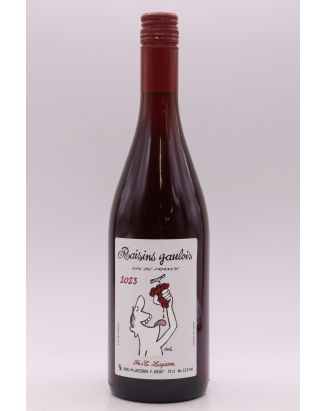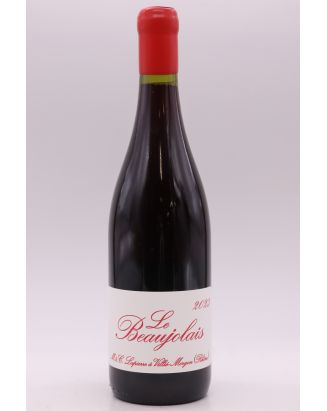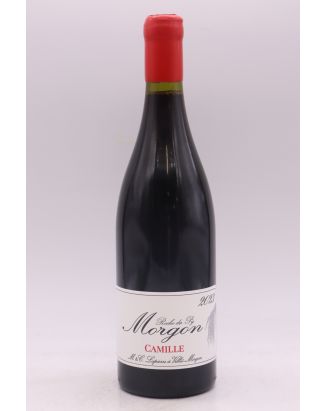








The Marcel Lapierre Estate was established in 1909, founded by Michel Lapierre, a Beaujolais winegrower who settled in Villié-Morgon. His son, Camille Lapierre, continued the family venture after World War II. Camille quickly imposed his avant-garde vision by marketing his wine directly in bottles from the 1950s, a revolutionary idea at the time.
In 1973, Marcel Lapierre, Camille's son, took over the reins of the estate and marked a decisive turning point. Inspired by Jules Chauvet, a famous researcher and winemaker, Marcel adopted a radically different approach: he decided to cultivate his vines without chemical fertilisers and abandon sulphur additions in winemaking. This approach, then against the current, quickly positioned him as a pioneer of "natural" wines, whilst respecting biodynamic methods.
Marcel's passing in 2010 did not extinguish the soul of the estate. Today, his children, Mathieu and Camille, perpetuate the family tradition with the same passion and commitment to organic agriculture and additive-free winemaking. They thus maintain the legacy of an estate that has profoundly marked the history of Beaujolais and natural wines in France.
The 18 hectares of the Marcel Lapierre Estate extend mainly over the Morgon appellation, one of the most prestigious crus of Beaujolais. This terroir is unique, both in its geological richness and its history. The soils of the region, predominantly granitic and acidic, are particularly suited to the Gamay Noir à Jus Blanc grape variety, carefully cultivated at the estate.
The estate's vines are planted on poor, well-drained soils, allowing the Gamay to express all its finesse and aromatic concentration. Among the emblematic plots, the Côte du Py stands out for its unique geological formation, composed of "blue stones", a rich and homogeneous granite. This terroir imparts incomparable intensity and aromatic complexity to the wines.
Since 1981, all the estate's plots have been worked organically, an avant-garde approach at the time. The Lapierres respect soil life, avoiding chemical weedkillers and favouring composting and superficial ploughing. This particular care for the soils is reflected in the exceptional quality of the harvested grapes, always hand-picked and meticulously sorted.
Winemaking at the Marcel Lapierre Estate is an art that respects both tradition and nature. The grapes, carefully harvested by hand, are quickly transported to the winery to avoid any alteration. The carbonic maceration method, used here, is a signature of Beaujolais. It allows whole bunches to be kept in a CO2-saturated environment, thus promoting aromatic extraction even before alcoholic fermentation. This technique, particularly respectful of the fruit's primary aromas, gives birth to fruity, fresh wines with fine tannins.
The estate also distinguishes itself by its refusal to use exogenous yeasts or chemical additives during fermentation. All cuvées are vinified using indigenous yeasts, naturally present on the grapes. This choice reinforces the expression of terroir and guarantees authentic wines, without artifice.
Another particularity of the Lapierre Estate lies in the near-total absence of sulphur during winemaking. The wines are closely monitored through regular microbiological analyses, and interventions are limited to physical gestures, such as pumping over or punching down, to preserve the purity of the juices.
The Marcel Lapierre Estate offers a varied range of cuvées, each reflecting the richness of its terroir and the purity of its winemaking.
Morgon : This emblematic cuvée of the estate, from the finest Morgon plots, offers dominant aromas of cherry, violet and liquorice. The Morgon from Domaine Lapierre has a beautiful tannic structure and ageing potential of about ten years. It represents the very essence of the Morgon cru, with wines combining finesse and complexity.
Cuvée Marcel Lapierre : Produced only in exceptional years, this cuvée pays homage to Marcel Lapierre. From the estate's oldest vines, located on the Côte du Py and Le Douby, it expresses intense aromas of black cherry and liquorice. It's a rare cuvée, produced in very small quantities.
Cuvée Camille : Named in honour of Camille Lapierre, this cuvée comes from old vines located on the Côte du Py, on poor and stony soils. It is distinguished by a long vatting and ageing in truncated cone wooden vats, offering subtle aromas of fresh red fruits and a nice length on the palate.
Le Beaujolais : This wine, resulting from carbonic maceration, is a lighter and fruitier expression of Gamay, with notes of raspberry and a hint of spices. It's an ideal wine to discover the estate's approach, with finesse and gourmandise.
Raisins Gaulois : A wine of pleasure par excellence, this cuvée is produced from the estate's young vines. Easy to drink, it offers explosive aromas of red fruits and a thirst-quenching freshness. It's an invitation to conviviality, while remaining true to the principles of natural wine.
Over the years, the Marcel Lapierre Estate has produced remarkable vintages that have marked the history of Morgon wines. Among the years to remember are: 2015, 2016, 2018, 2019, 2020...
These vintages, among others, testify to the Lapierre Estate's know-how and its adaptation to climatic conditions, while preserving the identity of its terroir.
If you appreciate the Marcel Lapierre Estate, you might also discover neighbouring estates, such as Domaine Jean Foillard, Domaine Jean Claude Lapalu, Domaine Dutraive, Domaine Jean Michel Dupré, Domaine Philippe Pacalet, Domaine Jules Desjourneys, Domaine Georges Descombes, Château Thivin, also emblematic of Beaujolais wines.
The Marcel Lapierre Estate alone embodies the spirit of the revival of Beaujolais wines and the natural wine movement. With an exceptional terroir, a philosophy deeply respectful of nature and wines of great purity, it is an essential reference for lovers of authentic wines. The estate's cuvées, marked by their terroir and vinified with minimal intervention, offer a unique tasting experience, faithful to the family heritage.